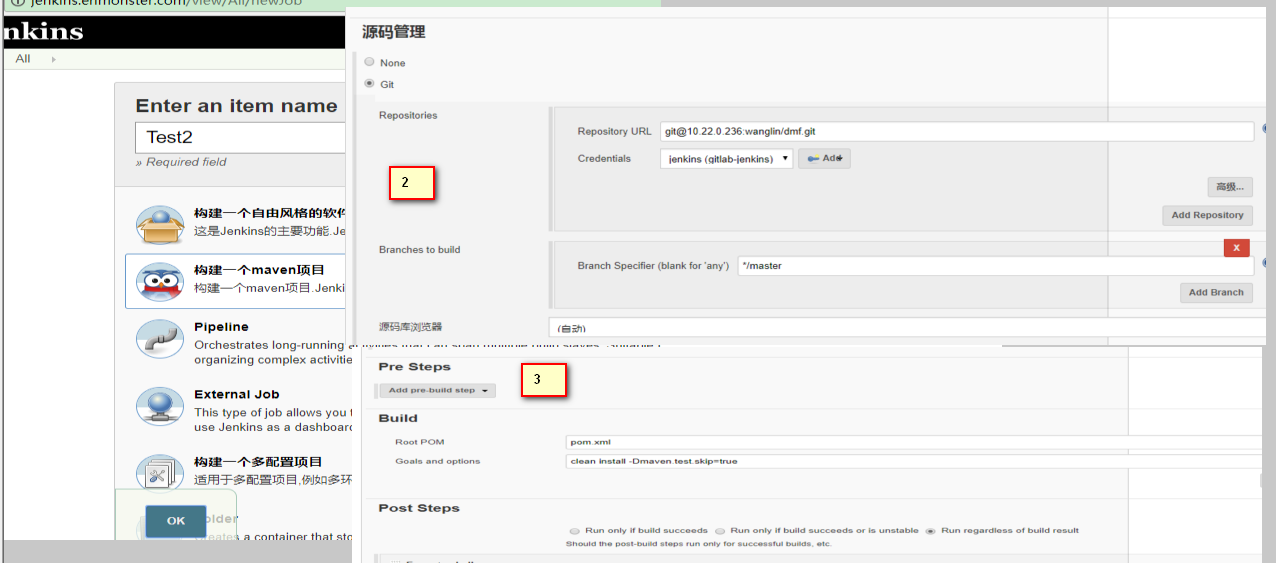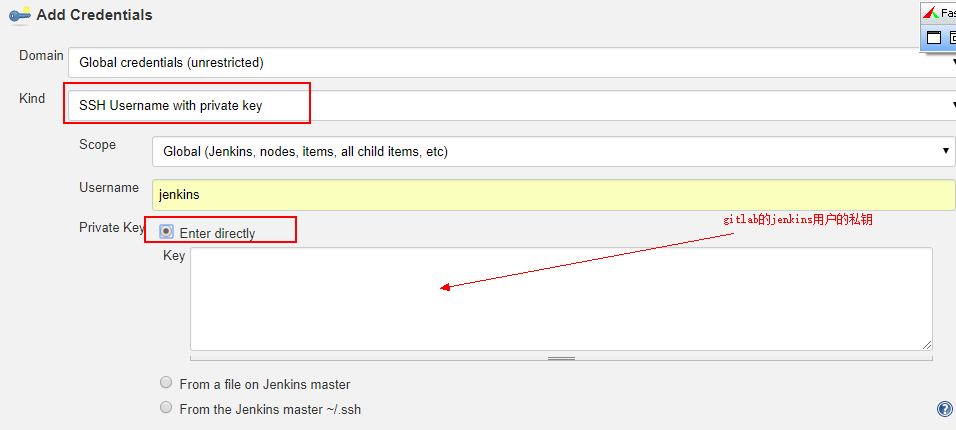gitlab+jenkins持续集成(二)
1.jenkins服务器上的配置
tar -zxvf apache-maven-3.3.-bin.tar.gz -C /opt/
yum install -y git
cat /opt/apache-maven-3.3./conf/settings.xml #只需更改maven的地址
<?xml version="1.0" encoding="UTF-8"?> <!--
Licensed to the Apache Software Foundation (ASF) under one
or more contributor license agreements. See the NOTICE file
distributed with this work for additional information
regarding copyright ownership. The ASF licenses this file
to you under the Apache License, Version 2.0 (the
"License"); you may not use this file except in compliance
with the License. You may obtain a copy of the License at http://www.apache.org/licenses/LICENSE-2.0 Unless required by applicable law or agreed to in writing,
software distributed under the License is distributed on an
"AS IS" BASIS, WITHOUT WARRANTIES OR CONDITIONS OF ANY
KIND, either express or implied. See the License for the
specific language governing permissions and limitations
under the License.
--> <!--
| This is the configuration file for Maven. It can be specified at two levels:
|
| 1. User Level. This settings.xml file provides configuration for a single user,
| and is normally provided in ${user.home}/.m2/settings.xml.
|
| NOTE: This location can be overridden with the CLI option:
|
| -s /path/to/user/settings.xml
|
| 2. Global Level. This settings.xml file provides configuration for all Maven
| users on a machine (assuming they're all using the same Maven
| installation). It's normally provided in
| ${maven.home}/conf/settings.xml.
|
| NOTE: This location can be overridden with the CLI option:
|
| -gs /path/to/global/settings.xml
|
| The sections in this sample file are intended to give you a running start at
| getting the most out of your Maven installation. Where appropriate, the default
| values (values used when the setting is not specified) are provided.
|
|-->
<settings xmlns="http://maven.apache.org/SETTINGS/1.0.0"
xmlns:xsi="http://www.w3.org/2001/XMLSchema-instance"
xsi:schemaLocation="http://maven.apache.org/SETTINGS/1.0.0 http://maven.apache.org/xsd/settings-1.0.0.xsd">
<!-- localRepository
| The path to the local repository maven will use to store artifacts.
|
| Default: ${user.home}/.m2/repository
<localRepository>/path/to/local/repo</localRepository>
-->
<localRepository>/opt/apache-maven-3.3.9/repo</localRepository> <!-- interactiveMode
| This will determine whether maven prompts you when it needs input. If set to false,
| maven will use a sensible default value, perhaps based on some other setting, for
| the parameter in question.
|
| Default: true
<interactiveMode>true</interactiveMode>
--> <!-- offline
| Determines whether maven should attempt to connect to the network when executing a build.
| This will have an effect on artifact downloads, artifact deployment, and others.
|
| Default: false
<offline>false</offline>
--> <!-- pluginGroups
| This is a list of additional group identifiers that will be searched when resolving plugins by their prefix, i.e.
| when invoking a command line like "mvn prefix:goal". Maven will automatically add the group identifiers
| "org.apache.maven.plugins" and "org.codehaus.mojo" if these are not already contained in the list.
|-->
<pluginGroups>
<!-- pluginGroup
| Specifies a further group identifier to use for plugin lookup.
<pluginGroup>com.your.plugins</pluginGroup>
-->
</pluginGroups> <!-- proxies
| This is a list of proxies which can be used on this machine to connect to the network.
| Unless otherwise specified (by system property or command-line switch), the first proxy
| specification in this list marked as active will be used.
|-->
<proxies>
<!-- proxy
| Specification for one proxy, to be used in connecting to the network.
|
<proxy>
<id>optional</id>
<active>true</active>
<protocol>http</protocol>
<username>proxyuser</username>
<password>proxypass</password>
<host>proxy.host.net</host>
<port>80</port>
<nonProxyHosts>local.net|some.host.com</nonProxyHosts>
</proxy>
-->
</proxies> <!-- servers
| This is a list of authentication profiles, keyed by the server-id used within the system.
| Authentication profiles can be used whenever maven must make a connection to a remote server.
|-->
<servers>
<!-- server
| Specifies the authentication information to use when connecting to a particular server, identified by
| a unique name within the system (referred to by the 'id' attribute below).
|
| NOTE: You should either specify username/password OR privateKey/passphrase, since these pairings are
| used together.
|
<server>
<id>deploymentRepo</id>
<username>repouser</username>
<password>repopwd</password>
</server>
--> <!-- Another sample, using keys to authenticate.
<server>
<id>siteServer</id>
<privateKey>/path/to/private/key</privateKey>
<passphrase>optional; leave empty if not used.</passphrase>
</server>
-->
</servers> <!-- mirrors
| This is a list of mirrors to be used in downloading artifacts from remote repositories.
|
| It works like this: a POM may declare a repository to use in resolving certain artifacts.
| However, this repository may have problems with heavy traffic at times, so people have mirrored
| it to several places.
|
| That repository definition will have a unique id, so we can create a mirror reference for that
| repository, to be used as an alternate download site. The mirror site will be the preferred
| server for that repository.
|-->
<mirrors>
<!-- mirror
| Specifies a repository mirror site to use instead of a given repository. The repository that
| this mirror serves has an ID that matches the mirrorOf element of this mirror. IDs are used
| for inheritance and direct lookup purposes, and must be unique across the set of mirrors.
|
<mirror>
<id>mirrorId</id>
<mirrorOf>repositoryId</mirrorOf>
<name>Human Readable Name for this Mirror.</name>
<url>http://my.repository.com/repo/path</url>
</mirror>
-->
<!---mirror>
<!id>nexus</id>
<mirrorOf>nexussi</mirrorOf>
<name>nexusname</name>
<url>http://maven.enmonster.com/nexus/content/repositories/central/</url>
</mirror-->
<mirror>
<id>nexus</id>
<mirrorOf>central</mirrorOf>
<name>nexus private repository</name>
<url>http://maven.XXX.com/nexus/content/groups/public/</url>
</mirror>
</mirrors> <!-- profiles
| This is a list of profiles which can be activated in a variety of ways, and which can modify
| the build process. Profiles provided in the settings.xml are intended to provide local machine-
| specific paths and repository locations which allow the build to work in the local environment.
|
| For example, if you have an integration testing plugin - like cactus - that needs to know where
| your Tomcat instance is installed, you can provide a variable here such that the variable is
| dereferenced during the build process to configure the cactus plugin.
|
| As noted above, profiles can be activated in a variety of ways. One way - the activeProfiles
| section of this document (settings.xml) - will be discussed later. Another way essentially
| relies on the detection of a system property, either matching a particular value for the property,
| or merely testing its existence. Profiles can also be activated by JDK version prefix, where a
| value of '1.4' might activate a profile when the build is executed on a JDK version of '1.4.2_07'.
| Finally, the list of active profiles can be specified directly from the command line.
|
| NOTE: For profiles defined in the settings.xml, you are restricted to specifying only artifact
| repositories, plugin repositories, and free-form properties to be used as configuration
| variables for plugins in the POM.
|
|-->
<profiles>
<!-- profile
| Specifies a set of introductions to the build process, to be activated using one or more of the
| mechanisms described above. For inheritance purposes, and to activate profiles via <activatedProfiles/>
| or the command line, profiles have to have an ID that is unique.
|
| An encouraged best practice for profile identification is to use a consistent naming convention
| for profiles, such as 'env-dev', 'env-test', 'env-production', 'user-jdcasey', 'user-brett', etc.
| This will make it more intuitive to understand what the set of introduced profiles is attempting
| to accomplish, particularly when you only have a list of profile id's for debug.
|
| This profile example uses the JDK version to trigger activation, and provides a JDK-specific repo.
<profile>
<id>jdk-1.4</id> <activation>
<jdk>1.4</jdk>
</activation> <repositories>
<repository>
<id>jdk14</id>
<name>Repository for JDK 1.4 builds</name>
<url>http://www.myhost.com/maven/jdk14</url>
<layout>default</layout>
<snapshotPolicy>always</snapshotPolicy>
</repository>
</repositories>
</profile>
--> <!--
| Here is another profile, activated by the system property 'target-env' with a value of 'dev',
| which provides a specific path to the Tomcat instance. To use this, your plugin configuration
| might hypothetically look like:
|
| ...
| <plugin>
| <groupId>org.myco.myplugins</groupId>
| <artifactId>myplugin</artifactId>
|
| <configuration>
| <tomcatLocation>${tomcatPath}</tomcatLocation>
| </configuration>
| </plugin>
| ...
|
| NOTE: If you just wanted to inject this configuration whenever someone set 'target-env' to
| anything, you could just leave off the <value/> inside the activation-property.
|
<prof/opt/apache-maven-3.3.9/repo <id>env-dev</id> <activation>
<property>
<name>target-env</name>
<value>dev</value>
</property>
</activation> <properties>
<tomcatPath>/path/to/tomcat/instance</tomcatPath>
</properties>
</profile>
-->
</profiles> <!-- activeProfiles
| List of profiles that are active for all builds.
|
<activeProfiles>
<activeProfile>alwaysActiveProfile</activeProfile>
<activeProfile>anotherAlwaysActiveProfile</activeProfile>
</activeProfiles>
-->
</settings>
[root@jenkins apache-maven-3.3.]# tail /etc/profile unset i
unset -f pathmunge
MVN_HOME=/opt/apache-maven-3.3.
PATH=$PATH:$MVN_HOME/bin
export MVN_HOME
export PATH
2.jenkins页面上的配置
①maven配置 "Global Tool Configuration"



3.jenkins服务器上的配置

4. jenkins打通gitlab



gitlab+jenkins持续集成(二)的更多相关文章
- 持续集成之Jenkins+Gitlab实现持续集成 [二]
持续集成之Jenkins+Gitlab实现持续集成 [二] 项目:使用git+jenkins实现持续集成 开始构建 General 源码管理 我们安装的是Git插件,还可以安装svn插件 我们将 ...
- CentOS 7 Gitlab+Jenkins持续集成+自动化部署
基于上次的环境<部署Gitlab+Jenkins持续集成环境> 来实现自动化部署 系统管理–>插件管理–>安装以下插件: Credentials Plugin(默认已经安装) ...
- Jekens 配置多项目SCM GitLab+Jenkins持续集成环境
参考: 搭建GitLab+Jenkins持续集成环境图文教程 https://blog.csdn.net/ruangong1203/article/details/73065410 Jenkins中配 ...
- CentOS 7 部署Gitlab+Jenkins持续集成(CI)环境
持续集成概述及运行流程 : 持续集成概述 :持续集成(Continuous integration)持续集成是指开发者在代码的开发过程中 ,可以频繁的将代码部署集成到主干,并进行自动化测试 开发→代 ...
- GitLab+Jenkins持续集成
一.概述 GitLab是一个代码仓库,用来管理代码.Jenkins是一个自动化服务器,可以运行各种自动化构建.测试或部署任务.所以这两者结合起来,就可以实现开发者提交代码到GitLab,Jenkins ...
- 【Jenkins持续集成(二)】Windows上安装Jenkins教程
一.前言 Jenkins是一款开源 CI&CD 软件,用于自动化各种任务,包括构建.测试和部署软件. Jenkins 支持各种运行方式,可通过系统包.Docker 或者通过一个独立的 Java ...
- gitlab+jenkins持续集成(一)
1. 环境:CentOS7.0,jdk-8u91-linux-x64.rpm,jenkins 2.7.4 ,gitlab 9.2.2 2. 安装jdk,jenkins (rpm -ivh ...
- gitlab+jenkins持续集成(三)
构建: 需要将jenkins服务器上 jenkins用户的公钥发送给 目标服务器的gs用户,使得在jenkins上能用gs免密登录目标服务器 复制密钥到目标机器上(需要登录到的机器) ssh-co ...
- git+jenkins持续集成二-jenkins定时构建语法:定时构建语法
构建位置:选择或创建工程_设置_构建触发器 1. 定时构建语法:* * * * * (五颗星,多个时间点,中间用逗号隔开)第一个*表示分钟,取值0~59第二个*表示小时,取值0~23第三个*表示一个月 ...
随机推荐
- socket.io+angular.js+express.js做个聊天应用(二)
版权声明:本文为博主原创文章,未经博主同意不得转载. https://blog.csdn.net/www19940501a/article/details/27585321 接着上一篇 我用的开发工具 ...
- UVa 1412 - Fund Management(状压DP + 预处理)
链接: https://uva.onlinejudge.org/index.php?option=com_onlinejudge&Itemid=8&page=show_problem& ...
- Hadoop学习之路(三)Hadoop-2.7.5在CentOS-6.7上的编译
下载Hadoop源码 1.登录官网 2.确定你要安装的软件的版本 一个选取原则: 不新不旧的稳定版本 几个标准: 1)一般来说,刚刚发布的大版本都是有很多问题 2)应该选择某个大版本中的最后一个小版本 ...
- virtualbox+vagrant学习-4-Vagrantfile-6-SSH Settings
SSH Settings 配置命名空间:config.ssh config.ssh的设置涉及到将如何配置vagrant使其通过ssh访问你的计算机.与大多数vagrant设置一样,默认设置通常都很好, ...
- centos 6.8安装java环境
1.rpm -qa |grep java 查看当前是否有java已经安装了,部分centos系统已经安装了的openjava环境,但是很多项目不熟要求的是要必须是sun的java环境 2.yum ...
- MySQL(一)索引的创建和删除
索引是存储引擎用于快速找到记录的一种数据结构,这是索引的基本功能. 索引对于良好的性能非常关键.尤其是当表中的数据量越来越大时,索引对性能的影响愈发重要.接下来将讲述如何创建.查看和删除索引. 索引分 ...
- P2983 [USACO10FEB]购买巧克力Chocolate Buying
题目描述 Bessie and the herd love chocolate so Farmer John is buying them some. The Bovine Chocolate Sto ...
- MapReduce操作Hbase --table2file
官方手册:http://hbase.apache.org/book.html#mapreduce.example 简单的操作,将hbase表中的数据写入到文件中. RunJob 源码: import ...
- css笔记--用户界面样式
1.系统字体,系统颜色.根据关键字设置为系统某方面相同的字体和颜色 2.光标:鼠标移入时光标的不同显示方法,有十字键,手型:cursor:pointer;cursor:hand;要按顺序,cursor ...
- #leetcode刷题之路33-搜索旋转排序数组
假设按照升序排序的数组在预先未知的某个点上进行了旋转.( 例如,数组 [0,1,2,4,5,6,7] 可能变为 [4,5,6,7,0,1,2] ).搜索一个给定的目标值,如果数组中存在这个目标值,则返 ...
